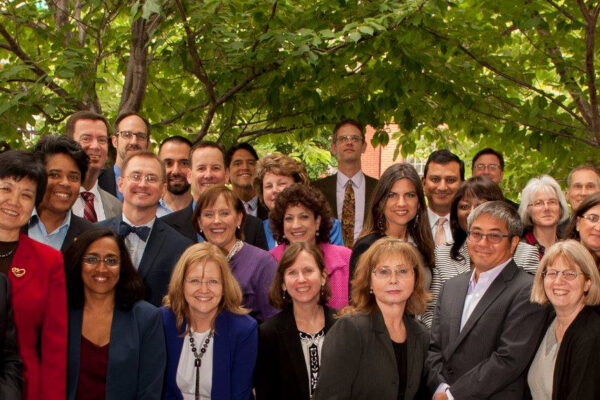 In her latest post, ACE Fellow Audrey Bilger argues for a leadership style that stresses “adaptive authenticity.”
In her latest post, ACE Fellow Audrey Bilger argues for a leadership style that stresses “adaptive authenticity.”
The ACE Fellows Program can be hard to explain.
For anyone interested in taking on the challenges of higher education leadership, it sounds too good to be true. Fellows have access to executive leaders at a host institution, receive special mentoring by their home institution and benefit from an array of resources designed to pave the way for future success, such as training, case studies, and an established network.
When I tell colleagues and friends about my ACE experience, they often look at me in disbelief, expressing amazement that home institutions would make such a significant investment and that host institutions would open their doors—and even confidential meetings—to outsiders. I am frequently asked, “What’s in it for them?”
I usually explain that fellows bring “fresh eyes” to our hosts and return to home with new ideas and perspectives; we work on projects, assignments, and reports. Now that I am at the mid-point of my ACE fellowship, however, I have come to the gratifying and somewhat daunting realization that the product of this year will be me—not as I was when I started this journey, but what promises to be a dramatically altered me.
Every experience I have had so far has required a level of self-scrutiny and questioning that has made the year unlike any other in my career. At the start of my year as an ACE Fellow, I pondered whether I was suited for a leadership role in higher education. Now, I spend time imagining what sort of leader I will be.
In shadowing the talented, energetic and creative executives at my host institution, the University of California Riverside, I get to see leadership styles that both resemble and differ from mine. I witness what works for them and imagine whether their approach might work for me in a similar situation.
As I contemplate how I might learn from these examples, I think a great deal about authenticity. While I recognize that some styles will simply come more naturally to me than others, at the same time, I am eager to try new approaches and see how they fit.
In a recent Harvard Business Review article, “The Paradox of Authenticity,” Herminia Ibarra discusses the current emphasis on authenticity in theories of leadership and declares, “a simplistic understanding of what it means can hinder your growth and limit your impact.”
According to Ibarra, “true-to-selfers”—people with a fixed sense of their own identity who say, what you see is what you get—are less able to lead effectively because that rigidity impedes their ability to consider other points of view. To combat the downside of an inflexible authenticity, she proposes that leaders cultivate an “adaptively authentic” style, one that evolves out of a “playful frame of mind.”
Think of leadership development as trying on possible selves rather than working on yourself—which, let’s face it, sounds like drudgery. When we adopt a playful attitude, we’re more open to possibilities. It’s OK to be inconsistent from one day to the next. That’s not being a fake; it’s how we experiment to figure out what’s right for the new challenges and circumstances we face.
ACE Fellows have a unique opportunity to develop the kind of adaptive authenticity Ibarra advocates. If, as she argues, “An important part of growing as a leader is viewing authenticity not as an intrinsic state but as the ability to take elements you have learned from others’ styles and behaviors and make them your own,” then the fellowship year is the perfect setting for playful experimentation. ACE Fellows are perfectly situated to follow one of Ibarra’s key pieces of advice: “Don’t copy just one person’s leadership style,” she writes, “tap into many diverse role models.”
Over the past months, I have gotten to know a remarkable team of leaders and have learned a great deal from their rich range of expertise. When I complete my fellowship and move on to whatever comes next, I am certain I will find myself recalling what this or that person did or said in a given circumstance. If it makes sense in the moment, I may echo their words or actions. In doing so, I will strive to preserve the learning spirit of my time as a Fellow and grow rather than limit my authenticity.
Ultimately, my class of ACE Fellows will be entrusted with the responsibility of serving as college and university leaders at a time when the very nature of our enterprise is embattled on many fronts. The stakes are high for everyone.
If we get it right, remaining true to our ideals and adaptably authentic, then the answer to that commonly asked question about the program could be profound: “What’s in it for the institutions we represent and visit?” A brighter future for higher education.
Audrey Bilger is the faculty director of the Center for Writing and Public Discourse and professor of literature at Claremont McKenna College. Her most recent book, Here Come the Brides! Reflections on Lesbian Love and Marriage, coedited with Michele Kort, was a 2013 Lambda Literary Award finalist. She is the author of Laughing Feminism: Subversive Comedy in Frances Burney, Maria Edgeworth, and Jane Austen. She is a member of the Ms. Committee of Scholars and serves on the editorial boards of Pickering and Chatto’s Gender and Genre series and the Burney Journal. Her work has appeared in Ms magazine, the Ms blog, the Paris Review, the San Francisco Chronicle, the Los Angeles Times, and The Los Angeles Review of Books. Follow her on Twitter at @AudreyBilger. Photo above by Greg Allen.
If you have any questions or comments about this blog post, please contact us.


